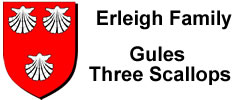CHAPTER SEVEN.
THE EARLES OF LINCOLNSHIRE.
Among the more prominent branches of the Earle family in Eng¬ land is that of Lincolnshire. In all probability, the ancestor of this branch was Richard, son of John de Erleigh (H 9) of the Somerset line. This John de Erleigh was the father of Sir John, “The White Knight,” but he also left a younger son, Richard, of whom we have no further account.
Sir Henry Earle, Bart., on one of his charts, makes this brother of Sir John de Erleigh the ancestor of the Lincolnshire Earles. In a letter, he says: “Lincolnshire certainly traces back to Richard de Erleigh, 6th degree from Sir Henry de Erleigh.” I do not know that the line of descent is definitely made out, but there is a strong probability.
The Lincolnshire family emerges into the clear light with Sir Richard Earle of Stragglethorpe, who was created a Baronet in 1629. Dr. Pliny Earle, in his “Genealogy of the Descendants of Ralph Earle,” gives “Craglethorpe” as the residence of Sir Richard, but Burke, in his account of the creation of the baronetcy, says “Stragglethorpe,” and Sir Henry writes, “Stragglethorpe, not Craglethorpe.” We do not know the distinction between the two names but believe it best to follow the authorities.
The Lincolnshire Branch
SIR RICHARD EARLE, 1st BARONET, was knighted and created a Baronet in 1629. He married Frances, daughter of Sir Edward Hartop, Bart. There were at least four sons,
- (B 1) John
- (B 2) Richard
- (B 3) Edward, born about 1635
- (B 4)William
Also, two daughters,
- (B 5) Elizabeth
- (B 6) Mary, who died in April 1646, and several others, names unknown, who died in infancy.
John Earle (B 1) had a son.
- Richard (C 1), who succeeded his grandfather in the baronetcy. This points to the death of John before his father.
Richard (B 2) succeeded to the title upon the death of his nephew (C 1).
Edward (B 3), b. about 1635, probably died young.
William (B 4) is claimed as the ancestor of a family of Earles County Wexford, Ireland. “The Rev. William Earle, Curate of St. Clement’s Danes, Strand, W. C. (of 16 Devereux Court, Temple, W. C.), son of the late George Earle, of Ballynahow, in Gorey, Co. Wexford, claims to be the great-great-great-grandson of Robert Earle, of Coolroe, Co. Wexford, who was said to be descended from a younger son (William) of 1st Baronet/’ (Burke.) On this ground he claims the title.
We call attention to these Irish Earles, said to be descendants of the Stragglethorpe family, for we shall find later that the Maryland Earles are inclined to trace their descent from the Stragglethorpes. The founder of the Maryland line, James Earle, styles himself in his will, “James Earle, late of Ireland.” Sir Henry Earle, Bart., writes: “It is well known that Stragglethorpes went to Ireland.”
Elizabeth Earle (B 5), apparently the only daughter of the 1st Baronet to reach maturity, married Thornhage (?) and had eight children. She made a claim to lands, as all her brothers and sisters were said to be dead. These claims led to lawsuits. She erected a strange monument to the memory of her mother, Frances Earle, on which she inscribed a full account of her rights. The stone states that nine of her brothers and sisters had died as infants.
At the decease of Sir Richard, 1st Baronet, the title and estates descended to his grandson,
SIR RICHARD EARLE, 2nd BARONET, son of John (B 1). He died without issue when the title reverted to his uncle, a younger son of the 1st Richard.
SIR RICHARD EARLE, 3rd BARONET, the second son of the 1st Baronet, married Hellena, daughter of William Welby, Esq., of Denton Hall, Lincolnshire, and had a son and daughter. He died about 1684, leaving title and estates to his only son,
SIR RICHARD EARLE, 4th BARONET, born in 1673, and died unmarried on August 13, 1697, aged twenty- four. The title, after thus belonging to four Richards in succession, now became extinct. Their lands passed to the Welby family.
A sister of the 4th Baronet married Gregory Gregory of Harlaxton Manor. He assumed the surname and arms of Earle. Their son and heir was Sir Earle Welby Gregory of Harlaxton Manor and Denton Hall, Lincolnshire. The latter had a son and heir, with whom the title became extinct in 1787.
But, though the title of the Lincolnshire Earles became extinct in 1797, the race did not. Sir Henry writes: “There were younger sons anterior to the baronetcy.” And again: “The three Sir Richards and their people are interminable. I have a mass of names there. One thinks he has it all and, behold, he finds another mass!”
